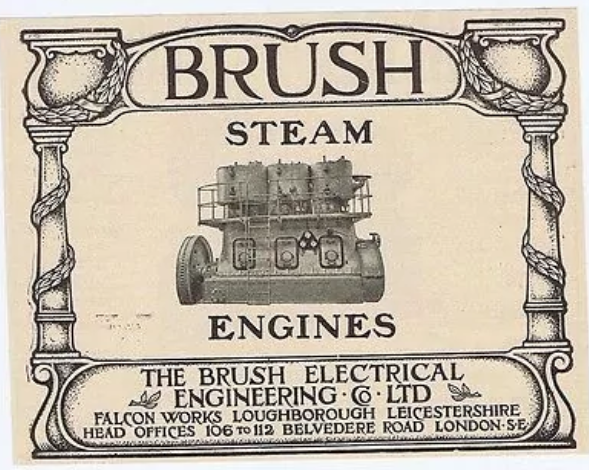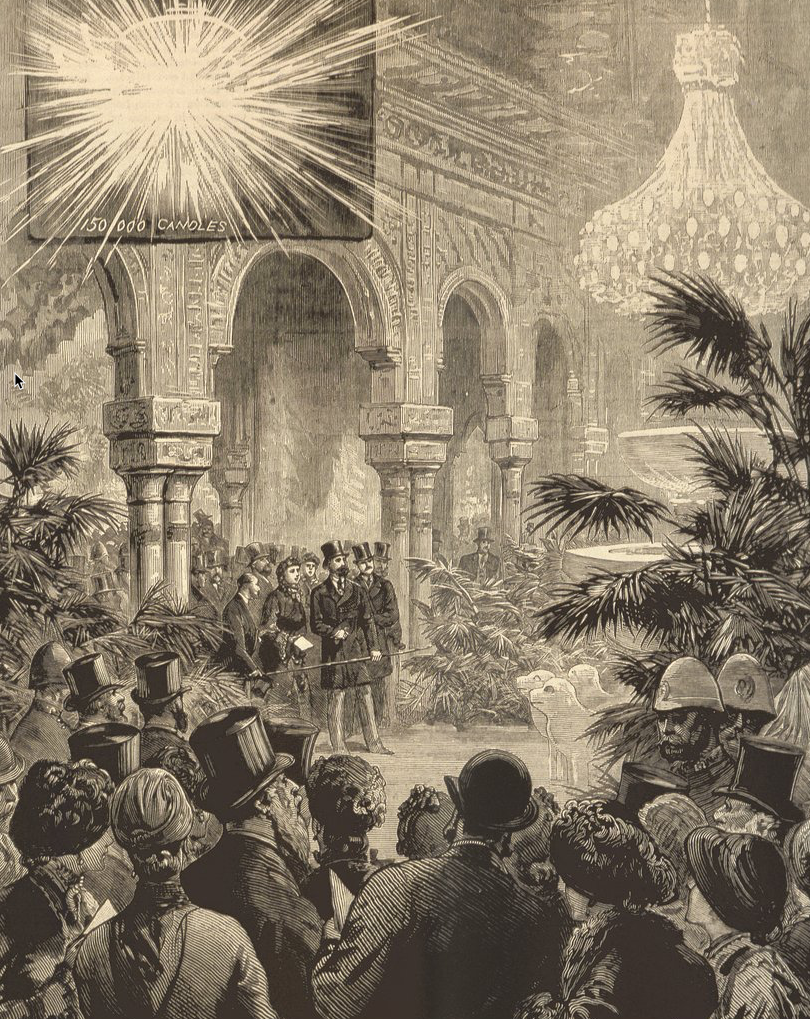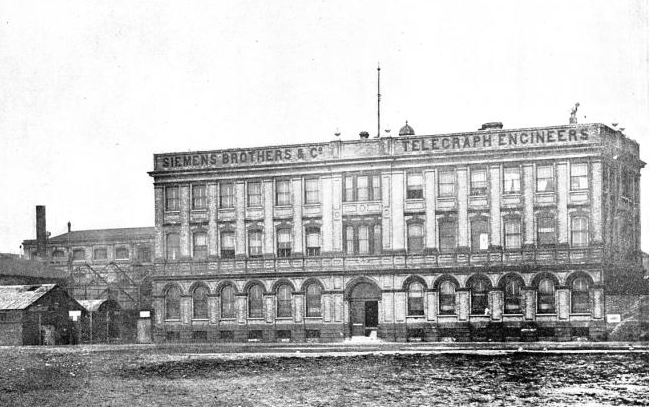3 October, 1891
Tom Chappell called with message from Gilbert,
decision of “making up” – promised to write to him.
Sent letter to Teddington by Louis – dined at Garrick.
Having returned from betting on horses, Sullivan is back in London, and suddenly, his diary becomes interesting! His long-time publisher and friend, Thomas Chappell is doing Yeoman’s Work, trying whatever he can do to patch things up between Sullivan and Gilbert. This effort will be fruitful, eventually resulting in Utopia, Ltd. But, who is this Teddington person? And was Sullivan really a member of the Garrick Club?
As I said, interesting. But first I promised you a conclusion to the story of Bertie’s Electrical Career.
At the end of Part 2, Sullivan’s nephew Herbert had apparently been “parked” in the tiny village of Rishangles, Suffolk, for several months from December, 1887 through to (potentially) April, 1888. I do not know why, except that Rishangles was close to where Sullivan had been living, at Brome Hall, and … erm … Sullivan probably needed to ditch Bertie, somewhere. Herbert had been working in Leeds at the factory of John Fowler & Co. Did that not go well? Sullivan’s diary makes no mention; if you know of other sources to fill in those details, please do tell!
But now Sullivan is in pain; “Last day at Brome and not yet rid of my bodily ailment” he wrote on 10 December, 1887. He had financial troubles, borrowing £2,000 (about £332,000 today) two days later. By 14 December his Dr. Cooper is visiting him twice per day. Gilbert is eager for them to begin work on their next show: he reads his plot for The Yeomen of the Guard to Sullivan on Christmas Day, for Christ’s Sake. Perhaps Sullivan simply didn’t need a feckless 19-year-old around at this time.
Sullivan was apparently still on good terms with his Portland mate, Robert Fowler. They played bezique together on 6 January, 1888. But that was almost the last entry in Sullivan’s diary mentioning the rich industrialist. On 16 January, Sullivan reports:
Drove out and called at Roger Eykyn’s – after a talk about Bertie’s prospects, he took me round to see Mr. Thompson ([?] J. Thomson & Son) the tea merchant. Mr. T said they would take Bertie for three years at a premium of £500 but could not guarantee him anything after that.
So, for a tuition of £500, Bertie could learn the tea trade. Maybe. There are no other entries of Sullivan having followed up that opportunity for his nephew. Roger Eykyn was a politician. By 1 April, 1888, Bertie was back in London, with Sullivan, his future career very much not yet sorted. And that’s how the year 1888 ended.
Pray, don’t fall asleep, Dear Reader.
Because the story finally picks up in 1889.
4 January, 1889
Went down to Charlton with Bertie, & saw the Manager of Siemens’ – arranged for Bertie to enter there following Monday. Hunted for lodgings, & found some at Miss __ Maryan[?] Road.
Yes, Siemens is the same company as today, only at a time when it was run by the original Siemens. Their factory in England at Charlton was only about 12 miles from Sullivan’s home in London. And even more coincidentally(?), they had created the electric lighting system for the Savoy Theatre in 1881. Also their factory in England was founded there to manufacture and lay submarine cables. Keep that in mind. But fast forward a year or so to:
18 July, 1890
Bertie came up to London early [Friday] – went with him to see Alex:[?] Siemens, who advised Bertie not to take the situation of Engineer at Carte’s new theatre.
Apparently Bertie has kept a position for more than a year! Additionally, we learn that Richard D’Oyly Carte has offered him a job as Engineer at the new opera theatre he is building especially to present English operas, starting with Sullivan’s Ivanhoe. Something to know about the position of “Engineer”: at this time, an Engineer was not so much a designer of new systems as a workman who maintained the engines that provided the electricity.
From July through October, 1890, Sullivan records visits from Bertie almost always on weekends, the image of a steady and stolid-y, jolly Bank-holiday, every-day young man. Then on 8 October, Sullivan writes that someone called “S. Seaton” came to visit “about Bertie.” He doesn’t record the reason for Mr. Seaton’s visit.

At this point in the story, we intersect the diary of Sir Arthur Sullivan with the excellent research of Mr. Bill Burns, who maintains the website History of the Atlantic Cable & Undersea Communications.
William Sharpey Seaton was an electrical engineer who had worked with Sir William Thomson (later Lord Kelvin) and had laid undersea cables. At this time, Seaton was engineer in chief of the Compagnie des Câbles Sous-Marins (the French PTT), based in Paris, and was the director of the upcoming expedition of the CS Westmeath (see photo).
On 15 October, 1890, Sullivan writes: “[Bertie] starts tomorrow in the “Westmeath” on Seaton’s staff, to lay a cable between Hayti [sic] & Brazil.” That was probably inaccurate. The first voyage of the Westmeath was to survey the ocean bottom between cable endpoints. See Burns’ excellent page here.
Bertie was away until 17 January, 1891. Then for three months he lived The Life of Riley, assuming Riley had been the nephew of a famous English composer and socialite. But on 3 April, “Bertie left at night for Calais to ship cable with Westmeath“. Bill Burns tells me this would have been in preparation for the actual laying of that cable. Herbert disappears from Sullivan’s diary from 4 April through to 19 September in 1891, so it’s possible that Bertie stayed on Westmeath for a second voyage.
On 20 September, the first we hear of Herbert being back in England, he arrives in London, coming from Sullivan’s rented home in Weybridge. Three days later, Bertie “moved into lodgings Palace St.” The “Palace St” part is my reading; the street does not appear in Dixon’s index of Sullivan’s diaries. Palace Street is quite close both to Buckingham Palace, and to Sullivan’s flat on Victoria Street.Wherever the lodgings were located, this is the first time we hear about Herbert Sullivan perhaps having a home of his own. Arthur Sullivan even dined with his nephew there, the following evening.
And now we’re finally back to 28 September, 1891, and the diary entries that started us off on this Bertie Adventure.
28 September, 1891
Went to city – called on Sir J. Pender about Bertie.
29 September, 1891
Went to Newmarket (1st Oct: Meeting) to stay
with Russie. wrote to Valabrègue etc. Bertie accompt
me to station & went to see Sir John Pender afterwards.
Sir John Pender, as mentioned in Part 1, founded 32 telegraph companies and laid thousands of miles of undersea cables, the very industry in which young Bertie now has some experience. But is Herbert employed now? I see no signs of that in Sullivan’s diary. Bertie came back from his voyages and settled into new digs in London. Now it appears we are back with another episode of What to do about Bertie?
Arthur Jacobs writes of the year 1892, “From this period his nephew remained by his side as a household companion.” This may be true in a general sense, but it obscures how that companionship probably began. As we saw in A mad dash to Haddon Hall, Sullivan began the year 1892 in Monte Carlo to work on his comic opera Haddon Hall, but soon became very ill. In April his servant Louis wired Bertie in London, and Bertie rushed to Monte Carlo to take over Sullivan’s affairs. If Herbert had been working, that job was dropped. Sullivan didn’t fully recover until late July.
Then in August, something odd happens in Sullivan’s diary. On 9 August, 1892 he writes “Bertie went to Loughborough”.
Loughborough?
In 1892 Loughborough, in Leicestershire, was a factory and mill town of maybe around 18,000 people. I know of no connection between either Sullivan and the town. From 9 August through to 10 November, Bertie’s visits to his uncle occur on weekends, and he always arrives from Loughborough. Bertie attended the Leeds Festival, which Sir Arthur conducted that year. After the festival, on 9 October, Sullivan wrote “All left Leeds 12.40. Bertie left us at Grantham.” Grantham is exactly the station between Leeds and London where Bertie would need to change trains to return to Loughborough.
I can only surmise that Bertie is now working in Loughborough. I can’t say for sure what he’s doing. Today, Loughborough is a university town. In 1892, it was not. But Loughborough did have one employer that might have interested a young man of 24 with some experience in electrical engineering.

Let me preface this reveal with the warning that I am about to state a hypothesis based solely on circumstantial evidence. Too often, in biography, an author tries to put 2 + 2 together, and their conclusion, sometimes erroneous, becomes part of a canon of received knowledge. Here, I am candidly making stuff up. But in Loughborough, in 1892 , there was a three-year-young company called the Brush Electrical Engineering Company, Ltd. They still exist, in Loughborough, as BRUSH. They have a long, proud history, making trains, electrical equipment, and even planes for the RAF.
References to Loughborough in Sullivan’s diary end on 10 November, 1892. On 12 November he “went to Brighton with Bertie to stay at the Waggs”. That was probably for horse racing. Sullivan soon after traveled back to Monte Carlo. After that, all of his diary entries for 1893 refer to Bertie in ways consistent with that of a rich young gentleman of no fixed occupation.
It appears Bertie’s Electrical Career was over. Though there is one more amusing anecdote, from Sullivan’s birthday on 13 May, 1894:
My birthday. 52! […] Preparing for party. At 1/4 to 8 main fuse went & all the lights went out! Bertie went to Main Station & got it put right.
Epilogue
I found the perfect person to enlighten me on everything Loughborough! That is writer, librarian, and Accredited Leicestershire Tour Guide, Lynne Dyer. She writes the amazing blog Lynne About Loughborough, and she clearly knows Loughborough stone-by-stone. According to Lynne, The Brush Electrical Engineering Co is indeed the most likely business to have employed Herbert Sullivan in 1892. Even more interesting, she points out that the Crystal Palace mounted a huge Electrical Exhibition that year, and both Brush and Siemens were among the exhibitors. Now if we could only find some connection between Arthur Sullivan and the Crystal Palace …
Epilogue to the Epilogue: But wait!
After writing this post, I discovered conclusive evidence that Bertie did work for the Brush Company, and did so at least through 1893! See Part 4 of 3.


